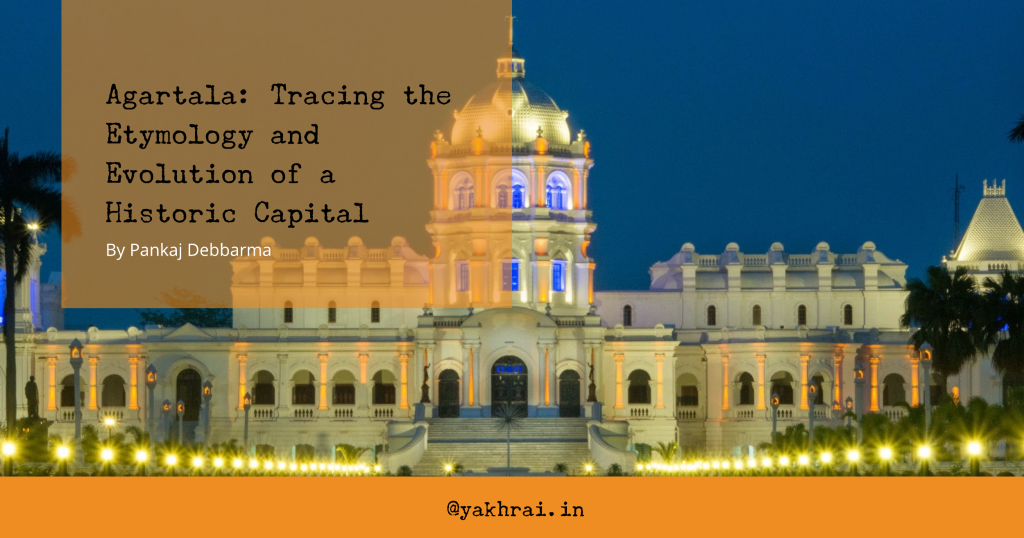By Pankaj Debbarma
October 24, 2023
Agartala, the capital of Tripura, boasts a rich history that not only reflects its name’s enigmatic origins but also encapsulates the essence of its strategic importance and evolving political landscape. The etymology of “Agartala” remains intertwined with local folklore, where it is believed to be derived from the abundance of ‘Agar’ trees or connected to Agar-Fa, the son of Maharaja Dangar Fa, reflecting the cultural heritage and legends of the region (Sur, 2010, pp. 13-14; Nath, 2020, p. 57).
The city’s narrative unfolds with Maharaja Krishna Manikya’s pivotal decision in 1760 to relocate the Tripura capital from Udaipur (Rangamati) to Old Agartala or Puran Haveli, marking the commencement of Agartala’s transformation into a significant urban centre (Sur, 2010, pp. 13-14). Over time, the capital shifted multiple times, driven by considerations of defence, communication, and political expediency, including Krishna Kishore Manikya’s move from Old Agartala to New Agartala or Natun Haveli in 1838 (Sur, 2010, pp. 13-14).
During the British colonial era, Agartala’s ascent as the capital of the ‘Hill Tipperah’ state further solidified its strategic significance. The reconstruction of the Ujjayanta Raj Palace after the devastating earthquake of 1897 by Radha Kishore Manikya not only exemplified architectural prowess but also underscored the city’s resilience and enduring importance as a political and cultural centre (Roychoudhury, 2023, p. 98).
The establishment of the Agartala Municipality during the reign of Maharaja Bir Chandra Manikya in 1871, within an area of 3 square miles, was a crucial milestone in its administrative history, as it laid the foundation for structured governance and development (Chaudhuri, 1995, p.9). The municipality’s formation marked a significant step in Agartala’s journey towards urbanization and modern governance, further shaping its identity as a significant political and administrative hub.
The planned reorganization of Agartala during the 1940s, under the leadership of Maharaja Bir Bikram Kishore Manikya Bahadur, emphasized the city’s pivotal role in the evolving political landscape and its potential as a hub for cultural and economic activities (Dey, 2020, p. 96).
Agartala’s journey from a modest village (Chaudhuri, 1995, p.9) to a vibrant urban hub attests to its adaptability and perseverance. The shifts in the capital’s location mirrored the city’s dynamic role in regional politics and trade, leaving a lasting mark on its cultural identity and historical narrative. Agartala’s history exemplifies the intricate interplay between political dynamics, geographical considerations, and the ever-evolving aspirations of its people, shaping its narrative to this day.
References:
Chaudhuri, D. K. (Ed.). (1995). Administration Report of the Political Agency, Hill Tipperah (1872-1878) Volume 1. Tripura State Tribal Cultural Research Institute & Museum, Govt. of Tripura, Agartala.
Dey, B. B. (2020). Glimpses in the Socio-Political Affairs of Tripura: Past and Present. Swagatam Prakashani, Agartala.
Nath, N. C. (2020). Sri Rajmala Volume I to IV. Tribal Research and Cultural Institute, Govt. of Tripura, Agartala.
Roychoudhury, N. (2023). Tripura through the Ages. Jnan Bichitra, Agartala.
Sur, H. K. (2010). British Relations with the state of Tripura (1760-1947). Nabachandana Prakashani, Agartala.

rVeDhWJXaO
brand cialis
buy cialis
tadalafil rankings
b12 injections online pharmacy
tylenol 3 pharmacy
buy viagra new york
sildenafil 20 mg in mexico
cialis alternative
vidalista tadalafil 60 mg
risperdal online pharmacy
can i buy viagra online with paypal
buy cialis usa
cialis bph
order cialis
cialis with food
over the counter generic sildenafil
best female viagra pills in india
what does a cialis pill look like
cialis cvs
cialis overnight pharmacy
lilly cialis coupons
sjs bactrim
flagyl klada
melatonin and zoloft
can you take cipro and flagyl together
hctz/lisinopril
furosemide class
mhra glucophage
cost of gabapentin
zithromax dosage sinus infection
amoxicillin and potassium clavulanate tablets dose for adults
escitalopram que es
can i take cephalexin with tylenol
fish ciprofloxacin
can cephalexin treat strep throat
amoxicillin vs bactrim
amoxicillin-pot clavulanate 875-125 mg
pediatric bactrim dosing chart
escitalopram and adderall
what are neurontin used for
cozaar and coughing
ddavp nasal drops dogs
citalopram lexapro
is depakote a narcotic
cozaar 10mg
ddavp nasal spray uses
depakote abuse
price of citalopram without insurance
augmentin sinus infection
diclofenac anti inflammatory
diltiazem 24hr er 120 mg cap
flomax versus ditropan
flexeril and ativan
ridgeway pharmacy contrave
amitriptyline while pregnant
aspirin tablets
aripiprazole 5
allopurinol and colchicine taken together
buspirone bupropion
augmentin treats
baclofen nursing considerations
mobic vs celebrex
iv buspirone
anxiety medication celexa
ashwagandha pills benefits
celecoxib sandoz
What’s up to every one, because I am actually eager of reading
this weblog’s post to be updated daily. It carries good material.
lamictal vs abilify
acarbose elderly
semaglutide 90 day supply
actos bleeding
repaglinide contre indications
is protonix bad for you
robaxin and tylenol together
remeron davis pdf
That is really fascinating, You’re a very professional blogger.
I have joined your rss feed and sit up for looking for more of your wonderful
post. Additionally, I’ve shared your site in my social networks
fda sitagliptin
synthroid pamphlet
zestril 10 mg
birth control and spironolactone
can voltaren gel be used on hemorrhoids
what is tizanidine used for
half life of venlafaxine
tamsulosin kidney stone women
side effects of stopping zetia
zofran dosage injection
online pharmacy birth control pills
zyprexa lawsuit
can zoloft and wellbutrin work well together
splitting zofran odt
zyprexa odt
levitra online store
how to get cialis without doctor
levitra online pharmacy
cvs cialis over the counter
where to buy lisinopril without prescription
cialis precio
happy family medical store
п»їlevitra
cialis 20mg coupon
cialis international pharmacy
cheap sildenafil
access pharmacy viagra
how long does sildenafil take to work
tramadol us pharmacy review
what is sildenafil 100mg
online pharmacy adipex
vermox 500mg tablet